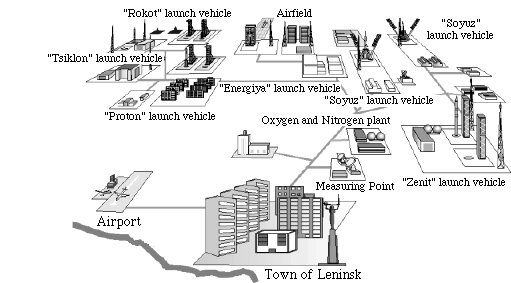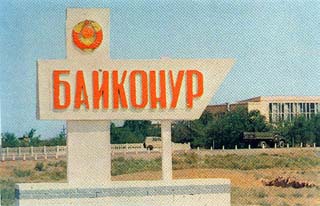

 |
 |
|
Baikonur Cosmodrome


The Baikonur Cosmodrome, the oldest space launch facility in the world, is the launch complex where the Earth's first artificial satellite, Sputnik 1, lifted off. The rocket that lifted Yuri Gagarin, the first human in orbit, was also launched from Baikonur. All Russian human spaceflight missions and all space station flights using Russian launch vehicles are launched from Baikonur, as are most geostationary, lunar, planetary, and ocean surveillance missions.
Baikonur is the only Russian launch site capable of launching the Proton launch vehicle.Baikonur can also accommodate launch of the N1 and Energia launch vehicles. The facility includes both surface and underground launch pads as well as ground control stations used to track launches and communicate with orbiting spacecraft, and a 1500-kilometer rocket test range. Baikonur extends for 85 kilometers from north to south, and 125 kilometers from east to west.
The name Baikonur is misleading. In the 1950s, the former Soviet Union announced that its space launch operations were being conducted from the Baikonur Cosmodrome and released the coordinates of a small mining town, Baikonur, to describe its location. But the launch complex is not located at or near the mining town of Baikonur but is about 322 kilometers (200 miles) southwest of the real Baikonur, near Tyuratam in Kazakhstan. The Soviet Union misrepresented the location of its launch complex intentionally to hide its actual location. Although the true location is now known, the launch complex is still referred to as Baikonur. The Soviets built the city of Leninsk near the facility to provide apartments, schools, and administrative support to the tens of thousands of worker at the remote launch facility.
The Baikonur Cosmodrome is in a barren area of the Republic of Kazakhstan, approximately 2,100 kilometers (1,300 miles) southeast of Moscow. When the Soviet Union broke up, Baikonur ended up in territory of the Republic of Kazakhstan. The December 1991 Joint Activity in Space and Exploitation agreement, signed at the creation of the confederation of states of the former Soviet Union, recognized the importance of Baikonur and the need to maintain it for the benefit of all member states. After much discussion, the Russian Federation and Republic of Kazakhstan signed a lease agreement, whereby Kazakhstan would receive an annual fee for use of the complex. Although conditions at the site had deteriorated during the early 1990s, the situation improved with the new accord.
Like Plesteksk, Baikonur is located inland so that the lower suborbital stage of launch vehicles fall back onto former Soviet territory. The remote site was selected in 1955 after a search to find a site for the Soviet secret missile program and to accommodate the radio guidance system of the Soviet R-7 intercontinental ballistic missile (ICBM). Use of the site began in 1957, and American U-2 reconnaissance planes observed the launch facility soon after its first test flights. As of the start of the 21st century, the complex has hosted around 400 launches.
The complex experienced a catastrophic launch-pad explosion in October 1960 that killed almost 100 people at the site, including Marshall of Artillery Mitrofan Nedelin. This was the worst disaster in the history of rocketry.
|